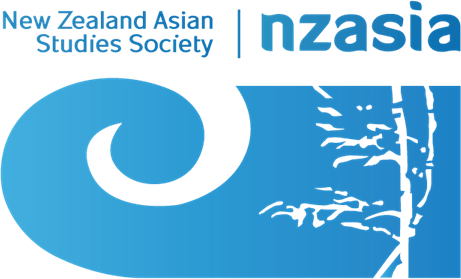Promoting Cantonese-New Zealand Heritage: A profile of Kirsten Wong and Nigel Murphy (Part 1)12/2/2021 By James Beattie, Victoria University of Wellington
NZASIA President James Beattie caught up with two energetic, long-time members of the New Zealand Chinese community, Kirsten Wong and Nigel Murphy, who have been working tirelessly to raise awareness of Cantonese heritage, history and community in Aotearoa New Zealand. Tell me both, please, how you became interested in aspects of Chinese New Zealand heritage? Kirsten: I grew up as part of a big extended family and was lucky enough to be surrounded by lots of amazing stories. I'm an only child so when the adults got together they would often talk as if I wasn't in the room. I got to hear all about my aunts and uncles' lives in Newtown in the 1930s and ‘40s. Stories like how my grandmother was so excited when she first got the family benefit and what she spent her money on. That was the first Labour Government [1935-49] which lifted the restriction on welfare payments to Chinese. So I grew up with a love for their stories, but also feeling the need to preserve that atmosphere that I grew up in and to make our Chinese New Zealand experiences visible. It's been a real calling for me. Nigel: I was with Kirsten in the early 1980s and because of that I was invited to the numerous family functions. One day we went and visited Uncle Ted (Ting) at his greenhouse at Otaki. He told us his father Chan Moon Ting had arrived in New Zealand on a windjammer in the late 1880s and gave us the name of the ship. I was working at the Turnbull Library at the time and thought I’d just go and check and see if he was right. So, the next day I decided to investigate and found - nothing. So, I looked for any primary source material on Chinese New Zealanders and again I found – nothing. National Archives – nothing. I said to myself, there must be something, these people were here during the gold rush of the 1860s, there has to be something! That started a long journey into Chinese New Zealand history which continues to this day. At the time my experiences with the Chinese New Zealand community had been so incredibly enriching that I thought, “how can I can pay back what I’ve been given?” So, I thought the best way to contribute was through history, helping them discover and reconnect with their histories in this country. A further element in the story was my father had been to Shanghai just after the end of WWII. He had also been very taken by the Chinese people he met there, by Chinese culture, and the way Chinese people approached life. He bought Chinese paper, ink, inkstone, brushes (Four Treasures of the Studio), as well as an abacus and some reproductions of the famous horse paintings by Xu Beihong which were on the walls of the family house as long as I could remember. He also bought a ‘teach yourself Chinese’ book which, as a ten-year old, I took up in a rather wildly ambitious attempt to learn how to read and write Chinese. I had yet to meet a Chinese person at that point. So, that’s how it all began. And, by the way, I still haven’t found out when Uncle Ted’s father came to New Zealand or on which ship, and I still haven’t learned how to read and write Chinese. But I know a lot about Chinese New Zealand history. Can you let me know about two current projects you are working on, and why you think they are important? Kirsten: This week I've been working on the Ventnor memorial project for the New Zealand Chinese Association (NZCA). On 9 December 2020, our Ventnor memorial was officially blessed alongside the newly opened Manea Footprints of Kupe Cultural Centre in Opononi. The memorial is for the 499 former Chinese miners whose remains were lost when the SS Ventnor sunk off the Hokianga coast in 1902. The NZCA memorial features the names of all 499 people whose remains were lost, plus the 13 passengers and crew who lost their lives in the sinking. The Ventnor story is really one of our community's most significant historical moments because it is literally a living piece of history. After the boat sank, remains began washing ashore and were picked up and cared for by those who lived along the coastlines, including people from Te Roroa and Te Rarawa who live to the south and north of the Hokianga Heads. They have been caring for the history and the remains since 1902. The Chinese community of descendants was only made aware of this in 2007. Since then we have formed close relationships with Te Roroa and Te Rarawa, Te Mahurehure and now Te Hua o te Kawariki Trust which is behind the Manea centre. This memorial was always about honouring our ancestors, but it was also to pay homage to the kind people of the Hokianga who have been caring for our ancestors' remains for all this time. We feel it's a history that should be remembered and celebrated, especially because of the values that make this story so special: the importance of ancestral heritage, the links to the land, the relationships within and between families and communities, and the importance of kindness. The memorial, we hope, will be just the beginning of an ongoing story. And to do a complete turnaround, the other thing I've been working on in the past few days has been NZCA's response to the New Zealand Qualifications Authority after writings by a white supremacist, Lionel Terry, were included in an NCEA Level 2 history exam. Terry murdered an elderly man, Joe Kum Yung, on Wellington's Haining St in 1905 to bring attention to his anti-Chinese views. The wonderful writer Chris Tse wrote an excellent Spinoff article about this: Rhymes of the ancient murderer: How a racist killer became an NCEA question There's also an incredibly powerful poem written by the young woman, Cadence Chung, who along with her friend Julia Randerson, first brought the issue to public attention. The poem is published on Poetry Shelf and is titled Shadows/Shades. Both are incredibly rewarding pieces of writing. Nigel: The major project at the moment is an update of the Poll Tax Report commissioned by the NZCA in 1992 as part of its campaign to obtain an official apology from the government for the poll tax (which was achieved in 2000) The update is very much expanded and includes a lot more background on the people who paid the tax, where they came from, how they got here, what sort of people they were, and what their life was like here. I’ve also discovered some facts that rather upturn the current narrative on the poll tax story from the New Zealand government side. I’m also involved in a project co-ordinated by Sydney Shep and Ya-Wen Ho 賀雅雯 from the Wai-te-ata Press at Victoria University to translate and publish – with contextual narrative – a series of poems written by the editor of the Dominion Federation of Chinese Commercial Growers Monthly Journal, and published in that journal in the late 1960s. They’re a fascinating insight into Chinese New Zealand life at the time, and I’m sure it will be a major contribution to Chinese New Zealand studies. I’m also contributing a chapter for an upcoming book on the extreme Right in New Zealand. The chapter will look at the ongoing influences of the 20th-century White New Zealand policies on Far Right attitudes and thinking in New Zealand in the 2020s.
2 Comments
Auriol Mckay
8/7/2021 12:40:01 am
Very interested in the history of chinese in New Zealand. I have close friends, contacts and my son has a Phd in literature of the Pacific region. He is now at University of Kyoto, Japan. Would love to do research paper in New Zealand (where he originally gained his doctorate) on Chinese culture
Reply
Lynette Shum
23/2/2023 07:50:17 am
Kirsten and Nigel are both taonga, thank you for this James
Reply
Leave a Reply. |
The views expressed in these blogs are not those of the NZASIA Executive and reflect the personal views of the blog authors.
Archives
December 2023
Categories |

 RSS Feed
RSS Feed
